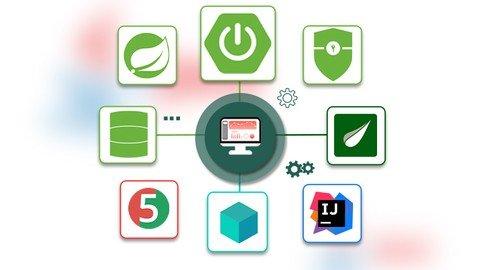Most Commented
Spring & Springboot Hands-On Experience (Full-Stack Project)




Description material

Last updated 12/2022
MP4 | Video: h264, 1280x720 | Audio: AAC, 44.1 KHz
Language: English | Size: 9.30 GB | Duration: 14h 43m
Developing Full-Stack Project: Spring Data JPA, MVC, Thymeleaf, Spring Testing (Mockito, JUnit), Spring Security, Maven
What you'll learn
Building a Full-Stack Java Spring Project
Implmenet back-end layer using Spring Data JPA
Securing the application and implement user roles using Spring Security
Implement front-end using Spring MVC Thymeleaf
Implmenet unit testing for the project using Mocoito
Implmenet unit testing for the project using Unit
Implmenet Intrgration Testing using Test Containers
Downloadable Source Code
Requirements
Java +8
SpringBoot
Description
Introduction to SpringBoot : Spring Boot is an open source Java-based framework used to create a micro Service. It is developed by Pivotal Team and is used to build stand-alone and production ready spring applications. This chapter will give you an introduction to Spring Boot and familiarizes you with its basic concepts.SpringBoot Advantages :Spring Boot offers the following advantages to its developers −Easy to understand and develop spring applicationsIncreases productivityReduces the development timeCourse Description : This course teaches how to build a full-stack application from the bottom up and touches on very import concepts used in real live software development .Course Objectives :Learn how to build system class diagram (UML) based on system buisness requirements. Learn to use Spring Initializr and how to contrcust the SpringBoot project.Learn how to develop Model layer using Spring Data JPA.Learn how to develop Business layer using Spring Service.Learn how to develop Unti testing using JUnit-5 and Mockito-4.Learn how to develop Integration testing using Test Containers.Learn how to develop Front-End using Spring MVC and Theymleaf.Learn how to develop Users Authentication and authorization using Spring Secuirty (Statefull)Learn how to use Maven Build tool.Using Mysql Database for data storing.Using best Java IDE while developer : Intellij IDEA.Explaining how to install the software on Windows and Linux.
Overview
Section 1: Course Overview
Lecture 1 Course Overview
Lecture 2 Course Sections
Lecture 3 Course Objectives
Lecture 4 Course Prerequisites
Lecture 5 Downloading Source Code
Section 2: Preparing Development Environment for Windows Os
Lecture 6 Step 1 : JDK Installation
Lecture 7 Step 2 : Download and Install Java IDE (Intellji IDE)
Lecture 8 Step 2 : Download and Install Java IDE (STS IDE)
Lecture 9 Step 3 : Download and Install Maven (Part 1)
Lecture 10 Step 3 : Download and Install Maven (Part 2)
Section 3: Preparing Development Environment for Linux Ubuntu
Lecture 11 Step 1 : Install/Update JDK 11
Lecture 12 Step 2 : Intellji IDE Installation (Part 1)
Lecture 13 Step 2 : Intellji IDE Installation (Part 2 : Change to Dark Mode (Optional) )
Lecture 14 Step 2 : Download & Install STS IDE (Part 1)[optional]
Lecture 15 Step 2 : Download & Install STS IDE (Part 2)[optional]
Lecture 16 Step 2 : Download & Install STS IDE (Part 3)[optional]
Lecture 17 Step 3 : Download and Install Apache Maven
Lecture 18 Step 4 : Create First Maven Application on IntelliJ IDE
Lecture 19 Step 4 : Create First Maven Application on STS IDE[Optional]
Lecture 20 Step 5 : Install MySQL & phpMyAdmin
Section 4: Project Analysis (Business Requirements)
Lecture 21 Buiness Analysis (Application Requirements)
Lecture 22 System Wireframes
Lecture 23 System UML Class Diagrams
Lecture 24 JavaCorner-Admin Demo (Show the final output)
Section 5: Implmenetation Step 1 : Implementing Model Layer using Spring Data JPA
Lecture 25 Agenda
Lecture 26 Step 1 : Choose Application Maven Dependencies
Lecture 27 Step 2 : Choose Application Maven Dependencies
Lecture 28 Step 3 : Create Entities & Relationships (Part 1)
Lecture 29 Step 3 : Create Entities & Relationships (Part 2)
Lecture 30 Step 3 : Create Entities & Relationships (Part 3)
Lecture 31 Step 3 : Create Entities & Relationships (Part 4)
Lecture 32 Step 3 : Create Entities & Relationships (Part 5)
Lecture 33 Step 3 : Create Entities & Relationships (Part 6)
Lecture 34 Step 3 : Create Entities & Relationships (Part 7)
Lecture 35 Step 3 : Create Entities & Relationships (Part 8)
Lecture 36 Step 4 : Add database configurations in application.properties
Lecture 37 Step 5 : Implement JPA Repository Interfaces (Part 1)
Lecture 38 Step 5 : Implement JPA Repository Interfaces (Part 2)
Lecture 39 Step 5 : Implement JPA Repository Interfaces (Part 3)
Lecture 40 Step 5 : Implement JPA Repository Interfaces (Part 4)
Lecture 41 Step 6 : Developing Helper Class to Test the Functionalities (Part 1)
Lecture 42 Step 6 : Developing Helper Class to Test the Functionalities (Part 2)
Lecture 43 Step 6 : Developing Helper Class to Test the Functionalities (Part 3)
Lecture 44 Step 6 : Developing Helper Class to Test the Functionalities (Part 4)
Lecture 45 Step 6 : Developing Helper Class to Test the Functionalities (Part 5)
Lecture 46 Step 6 : Developing Helper Class to Test the Functionalities (Part 6)
Lecture 47 Step 7 : Create the Application Database in phpMyAdmin
Lecture 48 Step 8 : Generate the Database Tables from Application ORM (Part 1)
Lecture 49 Step 8 : Generate the Database tables from Application ORM (Part 2)
Lecture 50 Step 8 : Generate the Database tables from Application ORM (Part 3)
Lecture 51 Step 8 : Generate the Database tables from Application ORM (Part 4)
Lecture 52 Step 8 : Generate the Database tables from Application ORM (Part 5)
Lecture 53 Step 8 : Generate the Database tables from Application ORM (Part 6)
Lecture 54 Step 8 : Generate the Database tables from Application ORM (Part 7)
Section 6: Implmenetation Step 2 : Implementing Business Layer using Spring Service
Lecture 55 Agenda
Lecture 56 Step 1 : Use Spring Data JPA project
Lecture 57 Step 2 : Remove Utility Package
Lecture 58 Step 3 : Create Service Interfaces & their Implementations (Part 1)
Lecture 59 Step 3 : Create Service Interfaces & their Implementations (Part 2)
Lecture 60 Step 3 : Create Service Interfaces & their Implementations (Part 3)
Lecture 61 Step 3 : Create Service Interfaces & their Implementations (Part 4)
Lecture 62 Step 3 : Create Service Interfaces & their Implementations (Part 5)
Lecture 63 Step 3 : Create Service Interfaces & their Implementations (Part 6)
Lecture 64 Step 3 : Create Service Interfaces & their Implementations (Part 7)
Lecture 65 Step 3 : Create Service Interfaces & their Implementations (Part 8)
Lecture 66 Step 4 : Add @Service & @Transactional Annotations to Services
Lecture 67 Step 5 : Update Application.properties file
Lecture 68 Step 6 : Write from your Application to Database & Test (Part 1)
Lecture 69 Step 6 : Write from your Application to Database & Test (Part 2)
Section 7: Implmenetation Step 3 : Implementing Testing Layer using SpringBoot Testing
Lecture 70 Agenda
Lecture 71 Step 1 : Use Spring Service Project
Lecture 72 Step 2 : Creating Unit Tests for Service Layer using Junit & Mockito (Part 1)
Lecture 73 Step 2 : Creating Unit Tests for Service Layer using Junit & Mockito (Part 2)
Lecture 74 Step 2 : Creating Unit Tests for Service Layer using Junit & Mockito (Part 3)
Lecture 75 Step 2 : Creating Unit Tests for Service Layer using Junit & Mockito (Part 4)
Lecture 76 Step 2 : Creating Unit Tests for Service Layer using Junit & Mockito (Part 5)
Lecture 77 Step 2 : Creating Unit Tests for Service Layer using Junit & Mockito (Part 6)
Lecture 78 Step 2 : Creating Unit Tests for Service Layer using Junit & Mockito (Part 7)
Lecture 79 Step 2 : Creating Unit Tests for Service Layer using Junit & Mockito (Part 8)
Lecture 80 Step 3 : Configuring Test Containers For Integration Tests (Part 1)
Lecture 81 Step 3 : Configuring Test Containers For Integration Tests (Part 2)
Lecture 82 Step 3 : Configuring Test Containers For Integration Tests (Part 3)
Lecture 83 Step 4 : Testing Repositories using TestContainers & DataJpaTest (Part 1)
Lecture 84 Step 4 : Testing Repositories using TestContainers & DataJpaTest (Part 2)
Lecture 85 Step 4 : Testing Repositories using TestContainers & DataJpaTest (Part 3)
Lecture 86 Step 4 : Testing Repositories using TestContainers & DataJpaTest (Part 4)
Lecture 87 Step 4 : Testing Repositories using TestContainers & DataJpaTest (Part 5)
Lecture 88 Step 4 : Testing Repositories using TestContainers & DataJpaTest (Part 6)
Section 8: Implmenetation Step 4 : Implementing Front-End Layer using Thymeleaf
Lecture 89 Agenda
Lecture 90 Step 1 : Use Testing Project
Lecture 91 Step 2 : Add Required Dependencies to pom.xml
Lecture 92 Step 3 : Create 'Course' Controller & Views (Part 1)
Lecture 93 Step 3 : Create 'Course' Controller & Views (Part 2)
Lecture 94 Step 3 : Create 'Course' Controller & Views (Part 3)
Lecture 95 Step 3 : Create 'Course' Controller & Views (Part 4)
Lecture 96 Step 3 : Create 'Course' Controller & Views (Part 5)
Lecture 97 Step 3 : Create 'Course' Controller & Views (Part 6)
Lecture 98 Step 3 : Create 'Course' Controller & Views (Part 7)
Lecture 99 Step 3 : Create 'Course' Controller & Views (Part 8)
Lecture 100 Step 4 : Create 'Instructor' Controller & Views (Part 1)
Lecture 101 Step 4 : Create 'Instructor' Controller & Views (Part 2)
Lecture 102 Step 4 : Create 'Instructor' Controller & Views (Part 3)
Lecture 103 Step 4 : Create 'Instructor' Controller & Views (Part 4)
Lecture 104 Step 4 : Create 'Instructor' Controller & Views (Part 5)
Lecture 105 Step 5 : Create 'Student' Controller & Views (Part 1)
Lecture 106 Step 5 : Create 'Student' Controller & Views (Part 2)
Lecture 107 Step 5 : Create 'Student' Controller & Views (Part 3)
Lecture 108 Step 5 : Create 'Student' Controller & Views (Part 4)
Lecture 109 Step 5 : Create 'Student' Controller & Views (Part 5)
Section 9: Implmenetation Step 5 : Implementing Security Layer using Spring Security
Lecture 110 Agenda
Lecture 111 Step 1 : Use Spring MVC Project
Lecture 112 Step 2 : Add Dependencies to pom.xml
Lecture 113 Step 3 : Create Security Configuration Class
Lecture 114 Step 4 : Implement User Detail Service
Lecture 115 Step 5 : Encode password using BCryptPasswordEncoder
Lecture 116 Step 6 : Adding role based restrictions to 'Course' Controller & Views (Part 1)
Lecture 117 Step 6 : Adding role based restrictions to 'Course' Controller & Views (Part 2)
Lecture 118 Step 6 : Adding role based restrictions to Course Controller & Views (Part 3)
Lecture 119 Step 6 : Adding role based restrictions to Course Controller & Views (Part 4)
Lecture 120 Step 6 : Adding role based restrictions to Course Controller & Views (Part 5)
Lecture 121 Step 7 : Adding role based restrictions to Instructor Controller & Views(Part 1)
Lecture 122 Step 7 : Adding role based restrictions to Instructor Controller & Views(Part 2)
Lecture 123 Step 8 : Adding role based restrictions to 'Student' Controller & Views(Part 1)
Lecture 124 Step 8 : Adding role based restrictions to Student Controller & Views (Part 2)
Lecture 125 Step 9 : Testing Applications based on Roles
Section 10: Course Summary and What's Next
Lecture 126 Course Summary
Lecture 127 What's Next ?
Java/Spring Developers who looking to practice real-time application

Buy Premium Account From My Download Links & Get Fastest Speed.
https://1dl.net/ugx9rvbdrqg4/Spring___Springboot_Hands-On_Experience___40_Full-Stack_Project__41_.part1.rar
https://1dl.net/unrg8eplhlsp/Spring___Springboot_Hands-On_Experience___40_Full-Stack_Project__41_.part2.rar
https://rapidgator.net/file/af35a39fc2e3e223ffae237f2b5a6ad8/Spring_&_Springboot_Hands-On_Experience_(Full-Stack_Project).part1.rar.html
https://rapidgator.net/file/af33088bb881801471a5a1ab6073f241/Spring_&_Springboot_Hands-On_Experience_(Full-Stack_Project).part2.rar.html
Join to our telegram Group
Information
Users of Guests are not allowed to comment this publication.
Users of Guests are not allowed to comment this publication.
Choose Site Language
Recommended news
Commented


![eM Client Pro 9.2.1735 Multilingual [Updated]](https://pikky.net/medium/wXgc.png)





![Movavi Video Editor 24.0.2.0 Multilingual [ Updated]](https://pikky.net/medium/qhrc.png)

